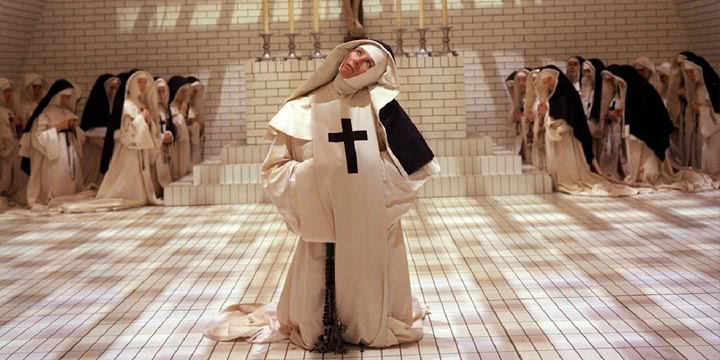In early 1971, British director Ken Russell completed his masterpiece.
A dark, profoundly surreal film about religious persecution and the infectious nature of insanity, The Devils was based in part on the novel The Devils Of Loudun by Aldous Huxley, though Russell injected Huxley’s carefully constructed narrative with his own trademark manic creativity and froth-mouthed madness.
Being a hysterical film about hysteria, then, The Devils was always unlikely to be beloved by the British ratings board. And in any case, Russell had never enjoyed a particularly good relationship with such institutions – though his 1969 film Women In Love was both Oscar-nominated and commercially fruitful, its controversial male-on-male nude wrestling scene brought down a fair share of ire and consternation onto the work, leading it to be banned completely in Turkey.

So no, given his history, Russell mustn’t have expected a warm reception from censors. But The Devils wasn’t merely trimmed or tutted at by the classifications board – it was straight-up mauled, not only by the board but also the studio that had commissioned the film in the first place.
It wasn’t simply The Devils’ sexual content that so incensed those who saw it, nor even its violence. The Devils shocked precisely because of its openly, flagrantly sacrilegious tone. After all, the work is less a film than it is a dark, satanic text, and a deliberate attempt to inspire intoxication and insanity in its audience. The film’s demonic intent comes to a particular head in the ‘rape of Christ’ sequence, a scene that sees Jesus Christ “debased”, as Russell himself put it, and one that lays plain the director’s triple-headed desire to shock, scintillate and seduce.
Indeed, as far as Russell was concerned, the ‘rape of Christ’ was the film’s “crux”. It was his spearhead, an unremittingly bleak visual condensation of everything the movie was about. But needless to say, such artistic concerns mattered little to the ratings board or to Russell’s studio. His film wasn’t re-edited – it was gutted, and that infamous scene was watered down.
But it wasn’t just that one sequence that was so trimmed. As Craig Lapper notes in his fantastic essay on the butchering of the film, ‘The Censors, The Studio And ‘Cutting The Orgy In Two’’, the British Board of Film Classification (BBFC) had an extraordinarily lengthy series of cuts it wanted made. Lapper quotes the letter the censors initially sent to Russell in February 1971, a document that would be profoundly amusing in its po-faced Britishness if it weren’t so constrictive. Cuts imposed by the BBFC included, “The removal of all sight of excrement on the Mother Superior’s leg after the enema is administered,” and “a reduction in the mime sequence to remove ‘dildo sucking’ and ‘red crotch’ shots”, among numerous other slashes.
The process was even worse in the United States. After undergoing heavy snipping, the film was initially released under the dreaded X rating, a tag often associated with outright pornography, before being further hobbled down into an R rating. As film critic and passionate The Devils scholar Mark Kermode hasnoted in one of his many essays on the film, Russell said studio executives and censors had “really let me have it”.

In that way, the mistreatment of The Devils perfectly set the stage for the moral fervour and restrictive censorship that would unfold in the ’80s, another mass panic centred around the new wave of violent horror films being released on videotape. That said, it is the ongoing restriction of The Devils that sets it apart from the so-called ‘video nasties’ that would follow in the decade after its release. Even today, some 45 years after it was butchered, a full cut of The Devils is still an elusive, mysterious beast.
Though there have been numerous versions of the film available on the home video market over the years, none have contained all of the material cut back in 1971: even the excellent two-disc edition of the film recently released by the British Film Institute does not contain all the material ripped from the work.
Nonetheless, in response to all that restriction, a not inconsiderable amount of resistance has emerged. Over the last few years in particular, the film has become a hotly contested topic, with a #FreeTheDevils hashtag circulating and Russell’s own widow, Lisi Tribble, vocally defending the work. Lauded horror director Guillermo del Toro has weighed into the fight as well, railing against “the powers that be at Warner Bros. that refuse to allow the movie to be seen”. And despite the fact he has been supporting the film for decades now, Mark Kermode has remained an impassioned, tireless voice in the debate, organising screenings and releasing television documentaries and video blogs about the censorship.
And for good reason. Films much more violent than The Devils have seen release, and sexualised content is no longer the shocking exception to the rule it was back in the ’70s. So why is the full cut of the film being denied release? The answer, sadly, points to unabashed, unadulterated moral policing.
In that way, the full release of The Devils isn’t about pleasing cinephiles. It’s about ethics. It’s about resisting any organisation that aims to decide what is and is not appropriate for the masses. And it’s about intellectual freedom, plain and simple.



































